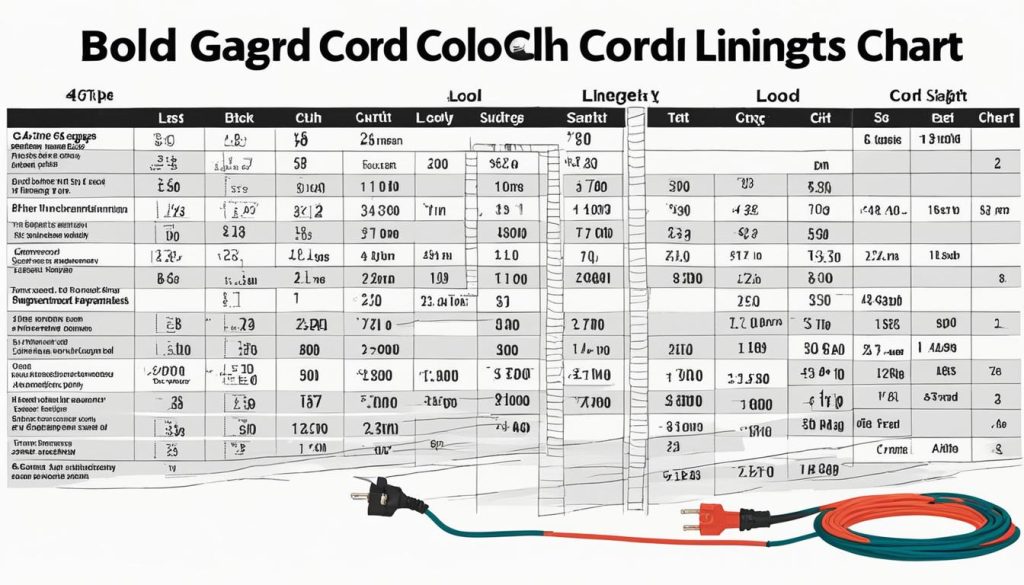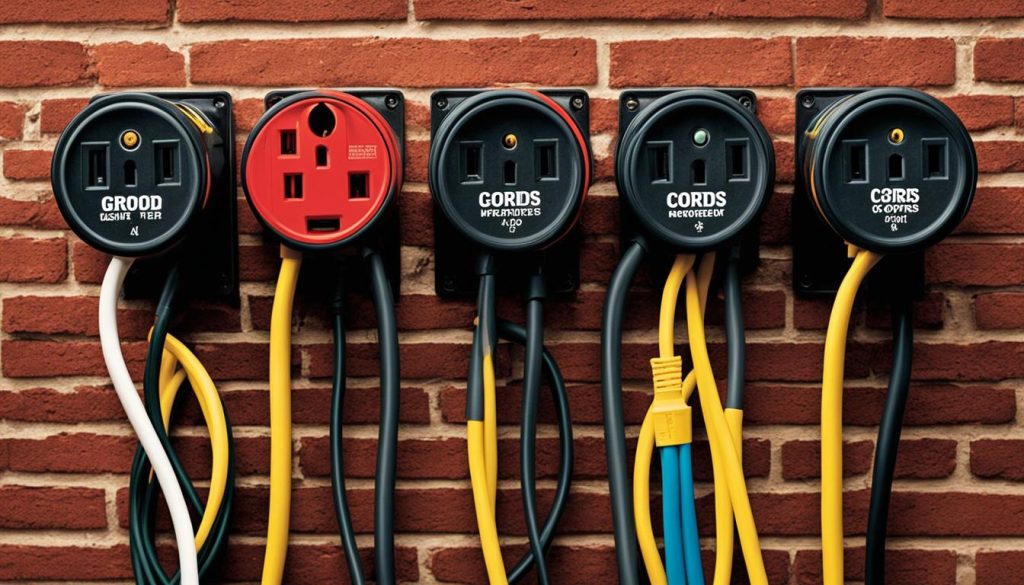After searching the Internet recently, we realized people needed a definitive extension cord size chart. This chart breaks down how both the wire gauge and length of an extension cord affect its ability to convey power to a corded tool. We broke our charts down by extension cord length since that’s where most people start when looking for the right gauge cord. Understanding wire gauge and amps and how they interrelate can protect your tools and keep you safe.
Here is a comprehensive extension cord gauge chart that provides valuable information on extension cord gauge sizes and wire gauges for different lengths of cords. With this guide, you can easily determine the appropriate extension cord for your specific needs.
Key Takeaways:
- Choosing the right extension cord gauge is crucial for safely powering your tools and appliances.
- Wire gauge refers to the thickness of the wire in the cord, with lower gauge numbers indicating thicker wires.
- Extension cord length affects the amount of power reaching the other end, with longer cords experiencing more voltage drop.
- There are three main types of extension cords: light-duty, medium-duty, and heavy-duty, each suitable for different power requirements.
- Ensure safe extension cord use by following safety guidelines, such as avoiding daisy-chaining cords and inspecting for damage.
Understanding Wire Gauge and Amps
When it comes to extension cords, understanding wire gauge and amps is crucial in order to choose the right cord for your needs. Wire gauge refers to the thickness of the wire in the cord. The lower the gauge number, the thicker the wire. Thicker wires can carry more current without overheating, ensuring safe and efficient power transmission.
The gauge of an extension cord determines how much power can flow through it without damaging the cord or causing a voltage drop. It’s important to match the gauge to the power requirements of your appliances to ensure optimal performance. Using an undersized cord can result in overheating, while using an oversized cord may be unnecessary and inconvenient.
How to Determine Extension Cord Gauge
Determining the appropriate gauge for your extension cord can be done by considering two main factors: the length of the cord and the power requirements of your devices. Generally, longer cord lengths and higher power requirements require thicker wire gauges.
To make this process easier, you can use an extension cord gauge calculator, which takes into account the length of the cord and the maximum current draw of your devices. By inputting these values, the calculator will provide you with the recommended wire gauge for your specific needs.
By choosing the right extension cord gauge, you can ensure that your appliances receive the necessary power without the risk of overheating or voltage drop. This not only protects your equipment but also promotes electrical safety in your home or workplace.
Choosing the Right Extension Cord Gauge
When selecting an extension cord, it’s essential to consider the gauge that best matches your power requirements. Here’s a helpful guide:
| Wire Gauge | Maximum Amps | Recommended Use |
|---|---|---|
| 16 | 13 Amps | Light-duty devices, such as lamps or clocks |
| 14 | 15 Amps | Portable power tools and smaller appliances |
| 12 | 20 Amps | Larger power tools and medium-sized appliances |
| 10 | 30 Amps | High-powered devices, including air conditioners or electric vehicles |
Remember, it’s always better to choose a slightly larger gauge than necessary to allow for future upgrades or increased power demands. Additionally, if you’re unsure about the specific gauge or have unique power requirements, consult a qualified electrician for expert advice.
Extension Cord Length Matters
The length of an extension cord plays a significant role in the efficiency of power transmission. As the cord becomes longer, it introduces more resistance to the current, resulting in a voltage drop. This means that the power reaching the other end of the cord will be reduced.
So, how do you ensure that enough power gets through?
First and foremost, it is always recommended to use the shortest length of extension cord possible. By minimizing the length of the cord, you can effectively minimize the resistance and maximize the power reaching your corded tool or appliance.
However, there may be situations where you need to use a longer cord. In such cases, it is essential to consider stepping up to a thicker wire gauge. A thicker wire has a lower gauge number, which translates to a greater ability to carry current without overheating. By using a higher gauge extension cord, you can compensate for the resistance introduced by the longer length and ensure that sufficient power is delivered.
Remember, choosing the right extension cord length and gauge is crucial for the optimal performance of your equipment, as well as the safety of your electrical system. Take into account the specific power requirements and consider using an extension cord length chart to guide your decision-making process.
Benefits of Using the Right Extension Cord Length:
- Maximizes power delivery to corded tools and appliances
- Minimizes the risk of power loss and voltage drop
- Optimizes the performance and efficiency of electrical devices
- Prevents overheating and potential damage to the extension cord and equipment
- Ensures the safety of individuals using the corded tools and appliances
Choose the right extension cord length and gauge to power your devices effectively and safely, ensuring seamless operation and longevity.

Different Types of Extension Cords
When it comes to extension cords, not all are created equal. There are three main types of extension cords available in the market: light-duty, medium-duty, and heavy-duty. Each type is designed to cater to specific power needs, ensuring the safe and efficient operation of your devices and appliances.
Light-Duty Extension Cords
Light-duty extension cords are the go-to choice for everyday household use and low-power devices. These cords are typically rated for 7 to 10 amps and come in various gauges, such as 16 or 18 gauge. They are suitable for powering small electronics, lamps, and charging devices. However, they are not recommended for heavy-duty appliances or tools that draw a significant amount of current.
Medium-Duty Extension Cords
Medium-duty extension cords are designed for standard devices that require a moderate amount of power. They are typically rated for 10 to 13 amps and come in gauges ranging from 14 to 16. These cords are suitable for devices like computers, televisions, speakers, and power tools with lower current demands. They strike a balance between the lightweight light-duty cords and the robust heavy-duty cords.
Heavy-Duty Extension Cords
Heavy-duty extension cords are built to handle high-power appliances and tools. They have thick wires and are capable of carrying currents up to 15 or 20 amps. These cords come in gauges ranging from 12 to 10 and are suitable for power-hungry devices like space heaters, air conditioners, and heavy-duty power tools. They are designed to withstand rugged environments and continuous use.
Remember, the right extension cord for your needs depends on the specific power requirements of your devices and appliances. Using the wrong type of extension cord can lead to overheating, damage to your devices, and even pose safety hazards.
| Type of Extension Cord | Suitable For | Gauge Options |
|---|---|---|
| Light-Duty | Small electronics, lamps, charging devices | 16 or 18 gauge |
| Medium-Duty | Computers, televisions, speakers, power tools | 14 to 16 gauge |
| Heavy-Duty | Space heaters, air conditioners, heavy-duty power tools | 12 to 10 gauge |
Choosing the right type and gauge of extension cord will ensure the optimal performance and safety of your electrical devices. Now that you understand the various types of extension cords available, you can make an informed decision and select the right one for your specific needs.

Safety Tips for Extension Cord Use
When it comes to using extension cords, safety should always be your top priority. By following these simple guidelines, you can ensure a hazard-free environment and protect both yourself and your electrical appliances.
Firstly, remember that extension cords are meant for temporary use only. Avoid using them as a permanent solution for powering appliances or tools. Additionally, resist the temptation to daisy-chain extension cords together. Plugging one extension cord into another can create a fire hazard and overload the circuit.
Choosing the right extension cord for the job is vital. Determine whether you need an indoor or an outdoor cord, as they are designed differently to withstand different conditions. Outdoor extension cords are typically more durable and have better insulation to protect against moisture and other weather elements.
Prior to each use, inspect the extension cord for any signs of damage, such as frayed wires or exposed metal. If you encounter any damage, do not use the cord as it can pose a serious risk. Finally, be mindful of the cord’s temperature during use. If it feels hot to the touch, it may be overloaded and could potentially cause a fire. Unplug and replace the cord immediately.
FAQ
What is wire gauge and how does it relate to extension cords?
Wire gauge refers to the thickness of the wire in the extension cord. Thicker wires have lower gauge numbers and can carry more current without overheating. The gauge of an extension cord determines how much power it can handle safely.
How do I determine the appropriate gauge for my extension cord needs?
You can use a gauge calculator to determine the appropriate gauge for your extension cord. This tool takes into account the power requirements of your appliances and the length of the cord.
Does the length of an extension cord matter?
Yes, the length of an extension cord affects how much power reaches the other end. Longer cords offer more resistance to the current, resulting in a voltage drop. It is recommended to use the shortest length of extension cord possible to minimize resistance.
What are the different types of extension cords?
Extension cords can be divided into three main types: light-duty, medium-duty, and heavy-duty. Light-duty cords are not suitable for high-current tools or appliances. Medium-duty cords are designed for standard devices like computers and speakers. Heavy-duty cords are used for heavy-duty appliances like space heaters.
How can I use extension cords safely?
To use extension cords safely, follow these guidelines: only use extension cords for temporary use, do not daisy-chain them together, choose the appropriate cord for your specific needs (indoor or outdoor), inspect cords for damage before use, and do not use a cord that feels hot to the touch.


